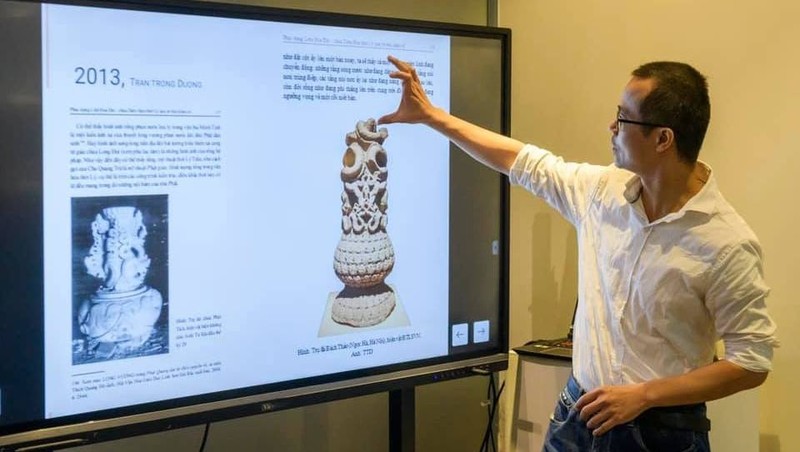Tran Trong Duong, co-founder of Sen Heritage, talks about the new features of this new reconstruction.
Q: Could you please share about reconstructing the Ly lantern post?
A: First, I have to mention the role of Hieu Sicula, a core member of Sen Heritage, in this reconstruction effort. As a painter devoted to culture and history, he made many drawings to reconstruct historical artefacts, based on extant archaeological objects.
In June 2017, a friend of Hieu sent him a photo of the stone base at the Phat Tich Temple, captured by the French and currently in the Ecole française d'Extrême-Orient (EFEO) in France. Looking at the picture, Hieu felt the object seemed to share some similarities with the Bach Thao stone pillar found at the Hanoi Botanical Garden, the lotus peak at the Bac Ninh Museum and the Sumeru throne base at the Phat Tich Temple.
The lower part of the Bach Thao stone pillar is carved with nine mountains and eight seas, a symbol of the world in Buddhist cosmology. The middle part features two Ly dragons curling around the pillar but with the heads and front hands of the dragons in the upper part missing.
In the meantime, in the photo of the Phat Tich stone pillar, the lower and middle sections are missing but the dragon head and the lotus throne still survive. From such complementary fragments, Hieu proposed the theory that these are parts of a lantern post, an important object in Buddhist rituals during the Ly Dynasty.
Q: Could you please tell us more about the reconstruction of the newly-born Shakyamuni Buddha statue on the Sumeru Throne?
A: This Sumeru throne can be applied to various objects, including a lantern post and a lotus throne supporting the newly-born Shakyamuni Buddha statue. These two theories are not contradictory but instead enrich our culture.
In order to come up with these two theories, our group members had to spend six months measuring and surveying many archaeological objects, alongside using information acquired over the past ten years.
With such data, we reconstructed the entire Sumeru throne with the newly-born Shakyamuni Buddha statue from the Ly Dynasty. It comprises three parts, of which the lower part is the foot of the pillar, a three-tier octagonal stone plinth. Next is the middle part of the pillar, featuring carvings of nine mountains and eight seas, two dragons playing with a pearl and a pedestal supporting the lotus throne. The upper part is a statue of the newly-born Shakyamuni Buddha made in the Gandhara style.
 |
A reconstruction of the newly-born Shakyamuni Buddha statue on the Sumeru throne by Sen Heritage
Q: Previously there were many interpretations about the objects and reconstruction of the newly-born Shakyamuni Buddha statue of the Ly Dynasty. How is Sen Heritage’s reconstruction different and which historical viewpoint is this reconstruction based on?
A: In 1954 French scholar Louis Bezacier released a photo of the space inside the Phat Tich Temple. In this photo, the upper part of the stone pillar is a statue of the newly-born Shakyamuni Buddha.
In 1988 architect Nguyen Ba Lang went a step further, stating that the object was from the Ly Dynasty. That is because the custom of worshipping the Shakyamuni Buddha was common in the 10th century, while the worship of the Avalokitesvara Boddhisatva did not begin until the 14th century.
In addition, completely separate from the Sumeru thrones at the Phat Tich Temple, which are stone bases supporting large Buddha statues, the Ly Sumeru throne is 1.6 metres tall, so placing a newly-born Shakyamuni Buddha on it was the most reasonable possibility.
Although archaeologists have yet to discover any complete Shakyamuni Buddha thrones, I believe that our reconstructed Sumeru throne, bearing the well-matched and refined Ly style, must be at the centre of a sacred space such as the altar of the Three Jewels or a place where ceremonies are performed such as the Long Tri Pond at the Phat Tich Temple.
After surveying the Long Tri Pond at the fourth layer of foundation, we found that the stone base at the bottom of the pond had been rubbed almost level but the foot of the base still shows traces of the nine mountains and eight seas, and dragon feet with paws. The pond also features a three-step pathway purportedly for the emperor or an officiating priest to conduct the ritual of bathing the Buddha.
From such information, we arrived at a theory that in the past the Long Tri Pond could have been an outdoor Buddhist structure with its centre being the newly-born Shakyamuni Buddha statue on a Sumeru throne, designed to serve the ritual of bathing the Buddha on his birthday.
Q: What do you think about the role of virtual reality in reconstructing the lantern post and the newly-born Shakyamuni Buddha Sumeru throne of the Ly Dynasty?
A: After reconstructing the newly-born Shakyamuni Buddha Sumeru throne, we also placed it within the space of the Dien Huu Temple. We imagine that the Buddha bathing ceremony could be conducted in the Linh Chieu Pond underneath the One-Pillar Lotus Pagoda. Through the VR and augmented reality (AR) technologies, viewers can both visit the One-Pillar Pagoda and watch the Buddha bathing ceremony on the full-moon day of the first lunar month or the Buddha’s birthday as described in the Sung Thien Dien Linh stele.
VR and AR technologies help visitors to step into the past and appreciate the value of Buddhist heritage through visual means. This is not only scientifically meaningful but also culturally significant, helping build a Vietnamese culture imbued with national characteristics.
Thank you very much.
















